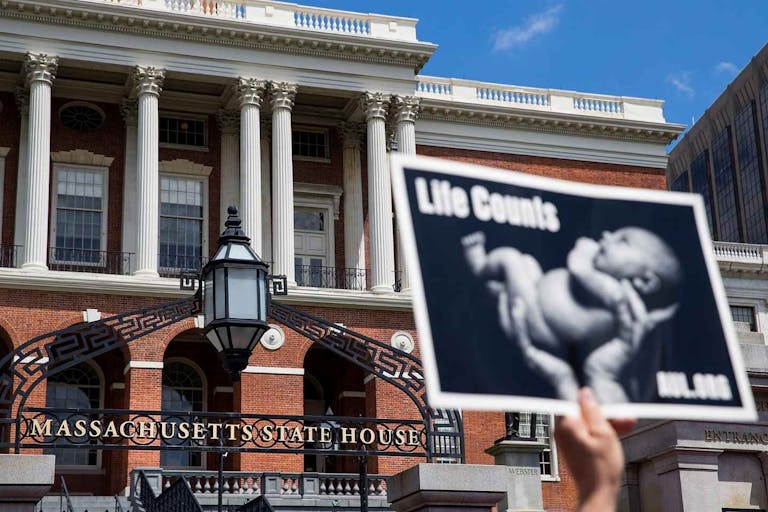
Massachusetts Health Department wants primary care to include abortion
Cassy Cooke
·
Guest Column·By Michael Spielman
Does poverty lead to abortion, or does abortion lead to poverty?
(Abort 73) Among its apologists, abortion has long been heralded for its purported social benefits—just as birth control was before it. By preventing “unwanted” children from being birthed, abortion is supposed to reduce strain on the system and create better outcomes for those already born. To that end, California taxpayers foot the bill for more than half the state’s abortions. In 2014, that amounted to almost 90,000 abortions—all in the name of fiscal responsibility. If this rather macabre investment strategy really does produce better outcomes for the state, you wouldn’t know it. On the fiscal scale, California ranks 8th from the bottom, which is the exact inverse of where it ranks with regard to abortion. Only seven states and districts abort a higher percentage of their children than California.
I realize of course that an almost infinite number of variables influences a state’s financial health. It would be naive to suggest that fiscal standing is directly attributable to abortion rates, but what if there is a symbiotic relationship between abortion and poverty? Last month the Centers for Disease Control (CDC) released their abortion surveillance report for 2014. Overall, “the total number and rate of reported abortions decreased 2%, and the ratio decreased 7%.” It’s that last number—abortion ratio—which is the most important because it measures total abortions against live births, allowing us to calculate the percentage of pregnancies that end in abortion each year. Among CDC reporting districts, 16.7% of pregnancies ended in abortion in 2013 (excluding miscarriages) and 15.7% ended in abortion in 2014. While that continues to move the needle in the right direction, it’s important to remember that when it comes to abortion, the United States is not a monolith.
The abortion ratio actually increased in 16 states/districts in 2014, stayed the same in North Dakota, and we don’t know what happened in California, Maryland, or New Hampshire—since they continually ignore the CDC’s annual request for abortion data. Just as financial health varies widely from state to state, so too does the abortion ratio. Whereas 33% of all pregnancies are aborted in the state of New York (according to the Guttmacher Institute), “only” 12% are aborted in Texas. And though 19% of Vermont pregnancies end in abortion, that number drops to less than 2% in Wyoming—a state of close to the same population. The CDC says it this way: “throughout the years, the incidence of abortion has varied considerably across subpopulations and remains higher in some demographic groups than others.”
READ: Abortion up to birth is legal in the United States. Here’s what that looks like.
Among the five states that are the most financially healthy (Florida, North Dakota, South Dakota, Utah & Wyoming), four have abortion ratios that are dramatically below the national average. On the other end of the spectrum, four of the five states that are the worst-off financially have abortion ratio that are well above the national average (Maryland, Massachusetts, Illinois & New Jersey). Of the 18 states that are financially “above average,” only two—Florida and Nevada—have higher-than-average abortion ratios, and of the 18 states that are financially “below average,” fully half have higher-than-average abortion ratios—which is even more significant when you consider that only 15 states in the country have higher-than-average abortion ratios (since those 15 states include four of the five most populous). At the very least, there is no evidence to suggest that high abortion ratios yield better fiscal results than low abortion ratios—it’s quite the opposite.
Most pundits would say that poor financial health leads to higher abortion ratios, but what if it also works the other way round? What if abortion isn’t just a result of fiscal problems but also a cause of fiscal problems? Though the CDC doesn’t track for wealth or education, their numbers reveal that in addition to state of residence, abortion ratios vary widely across two demographic lines: race and relationship-status. Among white women, 10% of pregnancies end in abortion. Among black women, it’s more than 29%. Not surprisingly, these numbers closely mirror the percentage of whites and blacks who live below the poverty line—9% for whites and 22% for blacks. Among married women, 4% of pregnancies end in abortion, but among unmarried women, that number jumps to 27%. Here again, the numbers are largely reflective of the corresponding poverty rates—5% for married women and 17% for unmarried. When two or more of the demographic traits associated with higher abortion ratios overlap, the numbers become even more startling. For instance, if a single black woman gets pregnant in New York, there’s at least a 49% chance1 her baby’s life will end in abortion—and it’s even higher if she lives in New York City. Poverty and abortion both are urban-centric.
The Centers for Disease Control comes to an unremarkable but revealing conclusion with regard to their 2014 abortion numbers. The report reads:
Article continues below
Dear Reader,
Have you ever wanted to share the miracle of human development with little ones? Live Action is proud to present the "Baby Olivia" board book, which presents the content of Live Action's "Baby Olivia" fetal development video in a fun, new format. It's perfect for helping little minds understand the complex and beautiful process of human development in the womb.
Receive our brand new Baby Olivia board book when you give a one-time gift of $30 or more (or begin a new monthly gift of $15 or more).
Despite the multiple influences on abortion, because unintended pregnancy precedes nearly all cases of abortions, efforts to reduce the incidence of abortion need to focus on helping women, men, and couples avoid pregnancies that they do not desire.
I suspect this is roughly the same conclusion they’ve come to each year for the last four decades. What makes it revealing is its inference about abortion. Doesn’t abortion itself “help” women, men, and couples avoid pregnancies that they do not desire? That’s what the pundits say. Why then does the CDC regard abortion as a failure of the system? Why do we need to “reduce the incidence of abortion” at all—if there is nothing wrong with abortion? At the risk of stating the obvious, there is something wrong with abortion. Specifically, it kills the most innocent and helpless members of the human community—and no amount of medical jargon can change that fact.

Sadly, the CDC’s recommended “solution” for unintended pregnancy is tired and uninspired. The report continues:
Providing contraception for women at no cost can increase use of these methods and reduce abortion rates. Cost, as well as insufficient provider reimbursement and training, inadequate client-centered counseling or youth-friendly services, and low client awareness of available contraceptive methods are common barriers to accessing contraception. Removing these barriers can help improve contraceptive use, thereby reducing the number of unintended pregnancies and consequently the number of abortions performed in the United States.
Their boilerplate conclusion is so familiar and sounds so reasonable that virtually nobody bothers to question it. Never mind the fact that there is no such thing as free birth control (that only means someone else is paying for it), their plea for more “youth-friendly services” completely ignores the actual data. Women under 20 account for only 10% of all abortions in the United States. Compared to 10 years ago, adolescents under 15 account for half the abortions they used to, women aged 15-19 account for 38% less, and women aged 20-24 account for 29% less. However, women aged 25-29 account for 14% more abortions than they did ten years ago, women aged 30-34 account for 18% more, women aged 35-39 account for 10% more, and women over 39 account for 13% more. In other words, younger women are having comparatively fewer abortions while older, wealthier and more-educated women are having comparatively more. This doesn’t fit the cultural narrative.
READ: Over 3,000 women tell Supreme Court: Abortion facilities lied to us
More significantly, free birth control may actually be leading to more unplanned pregnancies! Currently, 28 states require all health insurers to provide free prescription birth control to their subscribers. Of the 15 states and districts that abort 20% or more of their unborn children, all of them except Florida are among the 28 that mandate free birth control. Of the 30 states and districts with the highest abortion ratios, 26 mandate free birth control. Said differently, most of the states with the highest abortion ratios are the same states that mandate free birth control coverage—which creates another chicken-or-the-egg-type quandary. Are these states mandating free birth control because their residents abort such a high percentage of pregnancies, or do their residents abort such a high percentage of pregnancies because the state mandates free birth control? Birth control, after all, has always been a gateway drug to abortion.
In large measure, abortion is a self-fulfilling prophecy. Whereas birth is a declaration of faith and hope, abortion is a declaration of cynicism and fear. “Experts” will tell us that poverty makes abortion necessary, but what if abortion returns the favor by perpetuating more poverty? “Quality of life” is a fuzzy distinction, but it’s nearly impossible to argue that the health and emotional well-being of the average American child has improved in the 40+ years since abortion was legalized. Of the ten states that actually rate highest for overall quality of life, seven have abortion ratios below the norm. More significantly, of the ten states rated highest for government health and integrity, eight have abortion ratios below the norm—and nine have enacted state-level restrictions on abortion. On the other side of the ledger, only one of the 17 states that publicly funds abortion (Washington) is rated among the top ten for government health and integrity. That’s worth remembering the next time you hear Cecile Richards question the integrity of lawmakers who don’t roll out the red carpet for abortion. Abortion is fatal to innocent unborn children, but it’s scarcely less dangerous to the health and well-being of the society it purports to improve.
This percentage was arrived at by taking the total number of 2014 abortions performed on black women in New York (34,720) and multiplying it by .92 (since 92% of the black women who aborted in 2014 were unmarried). That number (31,942) is then added to the total number of 2014 births to black women in New York (46,744), multiplied by .71 (since 71% of the black women who gave birth in 2014 were unmarried). The sum of these two numbers (65,130) represents total pregnancies among unmarried black women in New York (excluding miscarriages). Dividing 31,942 (2014 New York abortions to unmarried black women) by 65,130 equals 49%.
Editor’s Note: This article was published at Abort 73 on December 28, 2017, and is reprinted here with permission.
Live Action News is pro-life news and commentary from a pro-life perspective.
Contact editor@liveaction.org for questions, corrections, or if you are seeking permission to reprint any Live Action News content.
Guest Articles: To submit a guest article to Live Action News, email editor@liveaction.org with an attached Word document of 800-1000 words. Please also attach any photos relevant to your submission if applicable. If your submission is accepted for publication, you will be notified within three weeks. Guest articles are not compensated (see our Open License Agreement). Thank you for your interest in Live Action News!

Cassy Cooke
·
Guest Column
Mark Lee Dickson
·
Guest Column
Right to Life UK
·
Politics
Tyler O'Neil
·
Guest Column
Mark Lee Dickson
·
Guest Column
Mark Lee Dickson
·